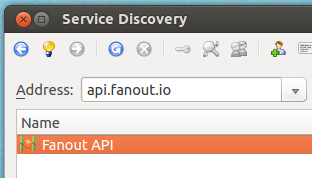subscribe via RSS
-
Goodbye, XMPP
Today we removed support for XMPP in Fanout Cloud.
Fanout’s XMPP functionality simply didn’t garner the adoption we were hoping for. It was never used at scale, and was mainly relegated to chat bots that needed compatibility with Google Talk. However, as Google phased out XMPP federation, such usefulness dwindled.
-
Publishing JSON over XMPP
At Fanout, we’ve developed a powerful publish-subscribe system for fronting custom APIs. Sometimes, though, API design is too much to think about and all you want to do is push some JSON.
To address this need, we initially created our own proprietary JSON-publishing protocol (a.k.a. “FPP”) and corresponding client library. This made it possible for developers to implement realtime updates in just a few lines of code, transported by magic. While this system worked well enough, it wasn’t terribly satisfying to have invented yet-another-protocol in order to accomplish this. Sure, every other pubsub cloud service has done the same thing, but the status quo makes for a bunch of redundant efforts that all achieve more-or-less the same result, and it hampers interoperability. So, lately, we’ve been looking into how we could adapt an existing standard for pushing JSON.
-
Using the API via XMPP
As you may know, Fanout Cloud supports delivering data to both HTTP and XMPP clients/endpoints. What you may not know is that the Fanout Cloud API itself is accessible via both protocols, too. This means that not only can you publish messages or make configuration changes via REST, you can perform these same tasks by sending XMPP stanzas. Why would you want to do this? Well, in certain cases, XMPP may be a more convenient or more optimal way of accessing the Fanout Cloud API. Additionally, the fact that you can use the API via one protocol but publish data to an endpoint of the opposite protocol allows for crossover possibilities. For example, you can use the REST API to fire off XMPP stanzas, or use XMPP ad-hoc commands to stream data to HTTP clients.

-
Standards at the edge
As I’ve been a long-time contributor to XMPP, people who know me are generally surprised to discover that Fanout Cloud is not in some way centrally powered by an XMPP server. XMPP is often touted as a solution for realtime communication among servers in a cluster. While this suggestion is not necessarily unsubstantiated, and many services operate this way today, the reality is that many applications have greater needs when it comes to messaging than your typical XMPP software stack provides. I’m talking about real queuing patterns, such as worker balancing, reliability, flow control, “job” queues, etc.
-
Realtime multicasting over HTTP/XMPP
Push is hard. Often, implementing realtime push in a website or web service means having to use unfamiliar software or frameworks. If it isn’t an XMPP server with BOSH, then it’s an esoteric HTTP server framework like Node.js or Tornado. Further, while the knowledge and tools necessary for load balancing a traditional web service are commonly found these days, scaling out and operating a push architecture is less straightforward. The interactions between server nodes are different. The traffic patterns are different. Even if you’ve got a handle on whatever particular approach for push you’re using today, do you know how you’ll scale it tomorrow?
 • filed under
• filed under